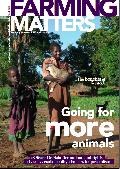Small-scale family farmers need these services too, but how do they profit best and how can service delivery become most sustainable? Should it be “public good”, financed and organized by the state, or can private corporations do a better job? Two views…
Private providers serve farmers best
Economic theory argues that private markets serve people’s individual needs best. For livestock services, this means that private providers are most efficient at delivering services such as artificial insemination and clinical veterinary care, (“private good” services).
The government should manage areas such as surveillance of contagious diseases, food safety and overall policy development (“public good” services). Some governments continue to provide clinical care, because they argue that poor farmers cannot pay for such services.
Recent evidence suggests that the poor do not necessarily benefit from subsidised services. The studies have also found that poor people are even willing to pay for good clinical care or artificial insemination for their dairy cattle. The evidence seems to suggest that commercialised private practice reaches more farmers, more equally, and at lower cost.
Yet, privatisation of veterinary services in different countries shows varying results, so is economic theory really a sufficient guide for policy reform? Why should private providers not deliver good quality services?
Firstly, many services may require high investments for private parties. Next, given the generally low education of poor livestock producers in developing countries, public veterinary authorities often make the point that private veterinarians are likely to resort to exploitative practices.
Although this does not justify public provision of clinical veterinary services, it does illustrate the importance of strong institutions in regulating behaviour, enforcing ethics, disseminating information and providing an effective regulatory and legal framework.
In poor, marginal areas, the demand is too low to sustain profitable private services. Possible alternative models are the use of membership organisations, self-help groups, civil society organisations, para-professionals or communitybased delivery systems. These tend to be far more responsive to local requirements than are government services. Thus, the recommendation to governments to privatise livestock services is too simple.
The situation differs from country to country: what are the available technology and skills, is there a vibrant private sector, how are corruption and transparency? In conclusion, there is a need for task sharing between the private and public sectors. A strong and accountable state can be responsible for policy development, pay for “public good” services, and regulate the delivery of “private good” services by the private sector.
The debate on livestock service delivery is therefore embedded in the larger debate on institutional development and political economy, that are part of larger economic reform agendas.
Text: Vinod Ahuja
Vinod Ahuja can be reached at vinod.ahuja@fao.org
Vinod Ahuja, Livestock Policy Officer, FAO Regional Office for Asia and the Pacific, India.
This piece represents the personal view of the author and does not necessary reflect the opinion of FAO
Not private, but democratic Veterinary Health Services!
During the past two decades, global financial institutions such as the IMF and World Bank have imposed neo-liberal economic reforms upon developing countries, which has meant a uniform “development prescription” to privatise and dismantle vital public services (healthcare, education, sanitation, water, and energy), including animal services.
The economists argue that health is a “private good” and that service demand is most effectively met by end-users purchasing their needs on the market. International institutions such as FAO and IFPRI advocate so-called “pro-poor” reforms for veterinary health care by creating private, self-supported community animal health workers. They are to deliver services on the doorstep at cost-recovery rates from farmers and charge user fees for veterinary services offered at government hospitals, while encouraging government veterinarians to become private practitioners. “Pro-poor” reforms place the responsibility for health services on the individual’s capacity to buy and sell these services. He is supposed to enter the “business” of healthcare.
Pushing veterinarians into privatisation leads to less accountability and not more, because they are forced to practice “health for profit” and not “health for all”. The oft-used argument that the “poor can pay” is flawed. Often, poor households go into debt in order to avoid losing a cow: what is then the impact of the debt on the household economy? What food do they have to miss? What unjust survival choices are they forced to make? If the poor could pay, they would not be poor!
The impact of privatisation in India is illustrative. Despite livestock and dairy contributing 6 percent to India’s current GDP, government development budgetary allocations to animal husbandry and dairying has decreased from 1.2 percent in the 1950s, to a pathetic 0.2 percent in 2010. The same period of economic reforms has witnessed a sharp decline in livestock ownership amongst the landless from 16 per 100 households in 1971-72 to just 1 in 2002-03, and the portion of the rural population unable to obtain the official nutrition norm of 2,400 kilo calories per day rose from 75 percent in 1993-94 to a high of 87 percent by 2004-05. In the same period, the average number of livestock increased only amongst the households owning more than 10 hectares of land.
Such figures show that the poor have been pushed out of livestock rearing, and profits have flown to the pharmaceutical and insurance companies. The nexus of government and private interests makes the former accountable to corporations rather than to its citizens.
The existing public veterinary health care system is far from perfect. Democratising the services would involve decentralised governance, appropriate extension work, prevention, accountability and transparency to farming communities. This demands greater public investment and not less, to enable a more effective and farmer-owned “free” service. Industrial agriculture is subsidised worldwide by a billion dollars a day without much ado. Why is the smallest subsidy on an essential service such as veterinary health, which is vital for the livelihoods of small peasants, argued away as economic inefficiency?
Text: Sagari R. Ramdas
Sagari R. Ramdas can be reached at anthra.hyd@gmail.com

